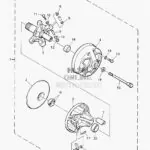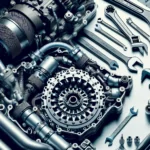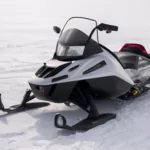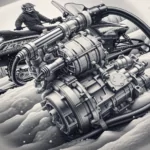Ever felt that your snowmobile isn’t performing to its best? Like it’s not responding to your throttle inputs as precisely as you’d like? You might be facing issues with the clutch, a common problem that indeed can seriously hamper your machine’s responsiveness. Get ready to learn some nifty tricks to adjust the clutch on your snowmobile, a skill that can make all the difference between a smooth ride through the snowy landscapes and a frustrating one.
Understanding the Role of the Clutch on Your Snowmobile
The clutch of your snowmobile plays an essential role in the overall function of your machine. It’s often referred to as the power transfer system, as it’s responsible for transferring the power from your engine to the drive belt, ultimately controlling the speed and performance of the snowmobile. Without it, the delivery of torque to your sled’s track isn’t possible.
The purpose of the clutch in a snowmobile
The primary function of the clutch in a snowmobile is to keep your engine’s RPM (revolutions per minute) under control. It permits the engine to reach maximum power at a high RPM and then maintain it while you’re cruising at a steady speed. It’s all about coordinating your engine’s speed, so your snowmobile operates efficiently.
Different components of the snowmobile clutch
Your snowmobile clutch comprises several components. The main ones include – the drive (or primary) clutch, the driven (or secondary) clutch, the clutch weights, springs, and the belt. The drive clutch is attached to your engine, while the driven clutch is on the snowmobile’s gearbox.
How a faulty clutch can affect the performance of your snowmobile
If your clutch is faulty, it can seriously impact your snowmobile’s performance. Poor clutching can lead to a sluggish response, decreased acceleration, poor power transfer, or inconsistent RPM. It can even cause damage to the belt. If you neglect the clutch, you could find yourself stranded in the middle of a snowy adventure.
Signs That Indicate Your Clutch May Need Adjustment
Recognizing the signs that your clutch needs adjustment is key to keeping your snowmobile running smoothly. Here are some main indications to watch out for:
Increased vibrations
Excessive vibrations during operation can indicate that your clutch balance is thrown off and requires adjustment.
Difficulties in changing gears
Information from your sled how it handles is also valuable. If you’re finding it hard to shift gears, it suggests a problem with your clutch.
Loss of engine power
An unexpected loss of engine power or decreased acceleration could mean your snowmobile’s clutch needs to be adjusted.
Abnormal noise from the clutch
Lastly, if you’re hearing any unusual noises coming from the clutch, it’s a clear indicator it requires inspection and probable adjustment.
Basic Tools Needed for Clutch Adjustment
Before you begin the clutch adjustment process, gather the essential tools for the job.
Adjustable wrench
An adjustable wrench will come in handy for loosening or tightening various nuts and bolts on your clutch.
Clutch holding tool
A clutch holding tool or a clutch removal tool may be necessary when you need to secure the clutch during adjustment or remove it for inspection.
Circlip pliers
Circlip pliers are used to remove or install the circlip that holds components of the clutch together.
Safety glasses and gloves
Don’t forget safety essentials like safety glasses and gloves to protect your eyes and hands while adjusting the clutch.
Accessing the Clutch on Your Snowmobile
Once you have the necessary tools, it’s time to access the clutch.
Locating the snowmobile’s clutch
The exact location of the clutch can differ between various snowmobile models, but generally, it will be found on the left side just beneath the body of the snowmobile.
Properly securing the snowmobile for clutch inspection
Ensure the snowmobile is on a stable surface and securely parked before starting your clutch inspection. It’s essential to ensure your safety and prevent any unnecessary movements.
Steps to expose the clutch for adjustment
You’ll need to remove the clutch cover, which usually involves unscrewing a few nuts and bolts. With careful removal, you’ll expose the clutch ready for adjustment.
Examining the Current Clutch Settings
The next step is to examine your snowmobile’s clutch settings and components.
Identifying basic clutch settings
Start by identifying the clutch’s basic settings. This could include the current tension of the clutch cable, the condition of the clutch weights, and the settings of the clutch springs.
Checking the tension on the belt
Next, take a look at the tension on the belt. If the belt is too tight or too loose, it can affect the overall operation of your snowmobile.
Analyzing the condition of the clutch’s components
Finally, analyze the condition of the components that make up your clutch to see if there are any visible defects or wear and tear. This includes the sheaves, the weights, and the springs.
Adjusting the Clutch Cable Tension
Adjusting the clutch cable tension is one of the most common tasks performed when adjusting a snowmobile’s clutch.
Understanding the purpose of clutch cable tension
The clutch cable connects the clutch lever to the clutch assembly. By adjusting the tension of the clutch cable, you can change how the clutch disengages and engages with the engine.
Steps to alter clutch cable tension
To adjust the clutch cable tension, locate the adjuster – usually placed near the clutch lever or clutch assembly – and tighten or loosen it as necessary using your wrench.
Checking the resistance in the clutch lever after adjusting tension
After adjusting the tension, you should check the resistance in the clutch lever. It shouldn’t be too tight or too loose; there should be just the right amount of give when you pull the lever.
Adjusting the Clutch Spring Tension
Clutch spring tension also plays an essential role in how your clutch operates.
Understanding the role of spring tension in clutch function
The springs in your clutch determine the ‘engagement speed,’ essentially the RPM at which your clutch begins to engage with the rest of the snowmobile’s components.
Steps to adjust the clutch spring tension
You can replace the springs with heavier or lighter ones to alter the clutch’s operating RPM. To do this, you’ll need to remove the springs using your Circlip pliers and swap them out with new ones.
Reevaluating clutch performance following spring tension adjustment
After adjusting your clutch springs, always remember to reevaluate the performance of your snowmobile to ensure the changes are effective.
Adjusting the Clutch’s Weights
The weights in your clutch also play a massive role in your clutch’s operation.
Exploring the purpose of clutch weights
The clutch weights affect how quickly the clutch engages and the operating RPM. They shift with the rotations of the clutch. Heavier weights mean faster shifting, while lighter weights generally slow the shifting down.
How to adjust clutch weights correctly
You can make the necessary weight adjustments by either changing the weights themselves with heavier or lighter ones or changing where the weights are situated on the clutch.
Ensuring balanced weight distribution in the clutch
A crucial point here is to ensure that the distribution of the weights is even. Uneven weight distribution can lead to poor performance and component wear.
Reassembling the Snowmobile Clutch
Once adjustments are done, it’s time to reassemble your snowmobile’s clutch.
Steps to follow when reassembling the clutch
Reassemble the clutch in the reverse order of how you disassembled it – replace any components you removed and ensure they are securely fitted.
Things to check before starting the snowmobile after clutch adjustment
Before you ignite the engine, check that all parts and components are not only present but tightened and well-positioned.
Safety Precautions During Clutch Adjustment
One should never ignore safety precautions during any mechanical undertaking.
Wearing appropriate protective gear
Remember, you must always wear appropriate protective gear during the process such as gloves, safety glasses, and closed-toe shoes to protect yourself from injury.
Ensuring snowmobile is securely parked during adjustment
Ensuring that your snowmobile is securely parked prevents unnecessary movement, which can cause possible harm or injury.
Understanding the risks associated with clutch adjustment
Finally, always understand the risks associated with adjusting your clutch. While doing it yourself can be exciting and rewarding, it’s not for everyone, and there’s no shame in asking for professional help if you’re uncertain. When in doubt, consult a professional.
- What Snowboard Bindings Should I Get? - January 23, 2024
- What Size Screws For Snowboard Bindings? - January 23, 2024
- How To Snowmobile On Water? - January 23, 2024









